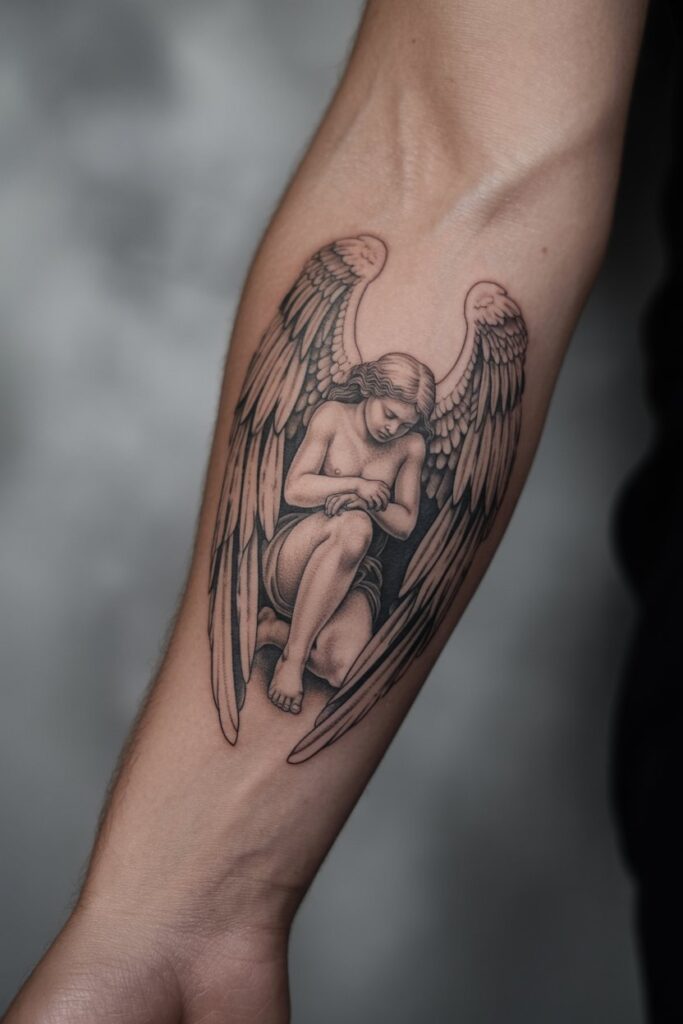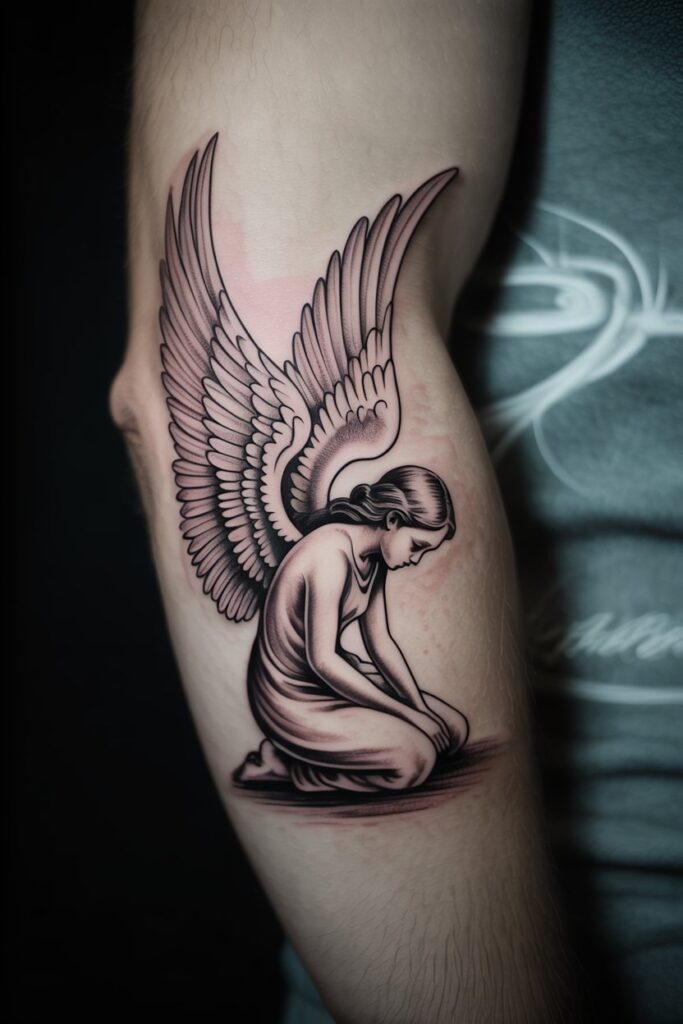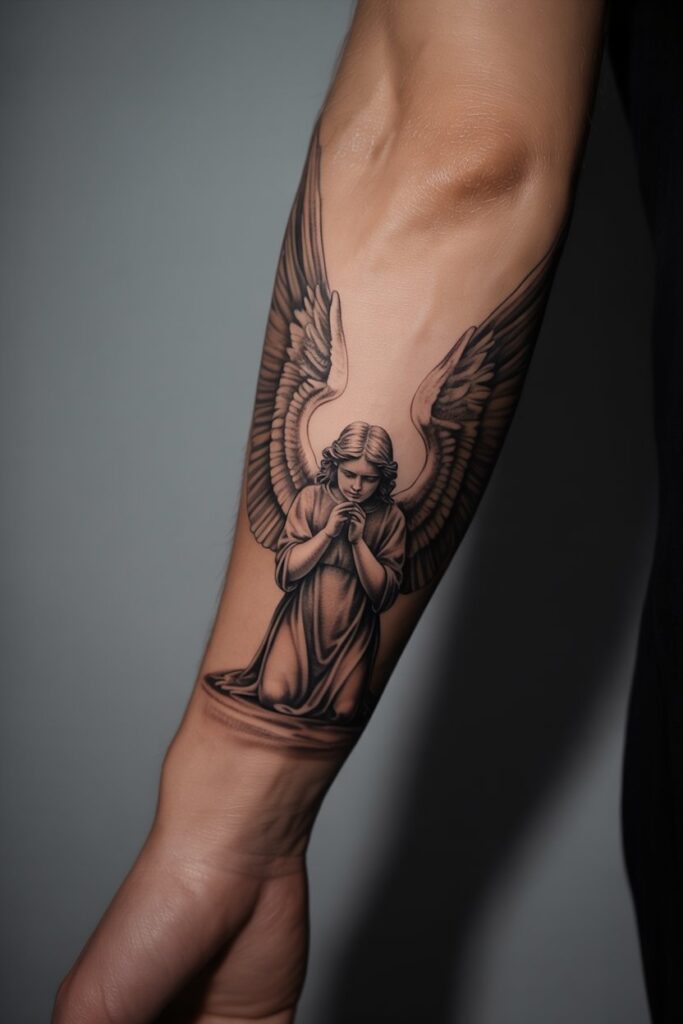In the profound world of spiritual tattooing, guardian angel designs stand as some of the most emotionally resonant and artistically challenging pieces. These solitary celestial beings, captured in moments of prayer, contemplation, and protective watchfulness, represent humanity’s deepest need for divine guidance and spiritual protection. Unlike the paired cherub designs that celebrate connection, guardian angel tattoos focus on the intimate relationship between the individual soul and its heavenly protector.
The Sacred Symbolism of Guardian Angel Tattoos
Guardian angel tattoos weave together multiple layers of spiritual and emotional significance, creating designs that serve as both artistic masterpieces and personal talismans:
Divine Protection and Guidance
The primary symbolic power of guardian angel tattoos centers on their protective nature:
- Personal guardian: The belief that each individual has a designated celestial protector
- Spiritual guidance: Divine beings offering direction through life’s challenges and decisions
- Protective presence: Constant watchfulness over the bearer’s physical and spiritual well-being
- Divine intervention: The possibility of miraculous assistance in times of need
- Sacred companionship: Never being truly alone, regardless of earthly circumstances
The solitary nature of these designs emphasizes the personal, intimate relationship between the individual and their celestial guardian.
Prayer and Intercession
The praying postures commonly depicted carry profound spiritual meaning:
- Mediation: Angels serving as intermediaries between human and divine realms
- Spiritual communication: The angel’s prayers lifting the bearer’s needs to higher powers
- Sacred contemplation: Moments of divine reflection and spiritual insight
- Blessing invocation: The act of calling down divine favor and protection
- Reverent worship: Recognition of divine authority and sacred presence
These prayer positions transform the tattoo into a permanent shrine of devotion carried on the body.
Memorial and Remembrance
Many guardian angel tattoos serve as powerful memorial pieces:
- Transformed souls: Loved ones who have become guardian angels watching over the living
- Spiritual connection: Maintaining bonds with departed family members or friends
- Comfort in grief: Visual assurance that the deceased continue to offer protection
- Eternal presence: The belief that love transcends physical death
- Heavenly reunion: The promise of eventual reconnection in the spiritual realm
The contemplative poses often reflect the peaceful state of souls at rest while remaining watchful over earthly loved ones.
Spiritual Awakening and Transformation
Guardian angel tattoos frequently mark significant spiritual journeys:
- Divine calling: Recognition of spiritual purpose or religious awakening
- Protection through trials: Acknowledgment of divine assistance during difficult periods
- Faith milestone: Commemorating deepening religious or spiritual commitment
- Gratitude expression: Thanksgiving for perceived divine intervention or blessing
- Spiritual armor: The tattoo serving as protective spiritual symbol
These designs often represent turning points in the bearer’s spiritual development.
Artistic Variations in Guardian Angel Design
The three distinct poses shown in these images represent different aspects of angelic symbolism and artistic approach:
The Kneeling Angel: Humility and Devotion
The first pose, featuring an angel in humble genuflection, embodies:
- Reverent submission: Recognition of divine authority and proper spiritual hierarchy
- Intercessory prayer: The angel praying on behalf of the tattoo bearer
- Spiritual humility: The beauty of submission to higher spiritual purpose
- Contemplative peace: Serene acceptance of divine will and guidance
- Sacred vulnerability: The strength found in spiritual openness and surrender
This positioning creates a sense of intimate spiritual communion between viewer and celestial being.
The Standing Prayer: Active Intercession
The second design shows an angel in upright prayer, suggesting:
- Active protection: Vigilant guardianship rather than passive watching
- Strength in prayer: The power of standing firm in spiritual conviction
- Ready assistance: Prepared to act on behalf of those under protection
- Balanced devotion: Combining reverence with strength and readiness
- Spiritual authority: Angels as powerful beings capable of divine action
The vertical composition emphasizes the connection between earthly and heavenly realms.
The Embracing Wings: Protective Shelter
The third angel, with wings wrapped around in self-embrace, represents:
- Nurturing protection: Maternal or paternal care from divine beings
- Sheltering love: Wings as protective covering against spiritual storms
- Comfort in sorrow: Divine consolation during times of grief or loss
- Introspective peace: The angel’s own communion with divine presence
- Encompassing care: All-surrounding divine protection and love
This pose particularly appeals to those seeking comfort and emotional healing.
Technical Mastery in Guardian Angel Tattoos
These sophisticated designs showcase advanced tattoo artistry through multiple technical approaches:
Realistic Human Anatomy
Creating convincing angelic figures requires mastery of human form:
- Proportional accuracy: Proper body proportions despite idealized celestial nature
- Facial expression: Capturing serenity, devotion, and divine peace in angelic features
- Anatomical detail: Convincing muscle definition and human physicality
- Gesture authenticity: Natural hand positions and body language in prayer
- Skin texture rendering: Creating believable flesh tones and surface details
These realistic elements ground the fantastical subject matter in believable artistry.
Wing Architecture and Detail
The wings in these designs demonstrate exceptional technical skill:
- Feather structure: Individual feather definition creating overall wing form
- Layered construction: Understanding how feathers overlap and create volume
- Perspective accuracy: Wings shown from various angles convincingly
- Light interaction: Realistic shadows and highlights across feathered surfaces
- Movement suggestion: Static wings that nonetheless suggest potential for flight
Wing work often separates exceptional angel tattoos from merely competent ones.

Advanced Shading Techniques
The dimensional quality achieved requires sophisticated shading skills:
- Chiaroscuro effects: Dramatic light and shadow creating sculptural volume
- Gradient transitions: Smooth tonal changes suggesting three-dimensional form
- Atmospheric depth: Subtle variations suggesting space and environment
- Selective highlighting: Strategic bright points bringing figures into focus
- Consistent lighting: Unified light source creating believable illumination
These techniques transform flat skin into apparently three-dimensional sacred art.
Drapery and Fabric Rendering
The flowing robes demonstrate advanced textile representation:
- Fabric weight: Different materials suggested through rendering techniques
- Natural folds: Convincing fabric behavior following body movement
- Texture variation: Smooth satins versus rougher materials clearly differentiated
- Movement capture: Fabric that appears to move with the figure
- Classical reference: Drapery work reminiscent of Renaissance and Baroque masters
Masterful drapery work adds elegance and classical dignity to angel designs.
Placement Strategies for Guardian Angel Tattoos
The substantial nature of these designs requires careful consideration of body placement:
Forearm and Lower Arm
A popular choice offering several advantages:
- Visibility control: Easy to display or conceal based on clothing choices
- Natural canvas: The relatively flat surface accommodates detailed figure work
- Viewing angle: Optimal perspective for both wearer and observers
- Proportional fit: Arm length accommodates full-figure angel designs
- Daily reminder: Visible placement for constant spiritual encouragement
The natural curve of the arm can enhance the three-dimensional quality of the figure.
Upper Arm and Shoulder
Traditional placement providing expanded canvas:
- Increased detail: More space allows for elaborate wing work and environmental elements
- Muscle enhancement: Natural body contours complement the angelic form
- Clothing flexibility: Professional concealment when needed
- Aging considerations: Minimal distortion over time in this stable area
- Expansion potential: Room for additional elements or complementary pieces
The broader canvas allows for more elaborate wing spreads and environmental details.
Back and Shoulder Blade
Large-scale placement for dramatic impact:
- Maximum canvas: Extensive space for full-figure angels with elaborate wings
- Symmetrical options: Potential for paired guardian angels on both shoulders
- Dramatic scale: Large designs create powerful visual statements
- Privacy control: Intimate placement for deeply personal spiritual pieces
- Architectural integration: Natural body lines enhance angelic poses
Back placement particularly suits designs with extensive wing spreads.
Calf and Lower Leg
Vertical placement complementing the elongated nature of standing angels:
- Proportional harmony: Leg length accommodates full-figure vertical compositions
- Canvas quality: Smooth skin surface ideal for detailed work
- Discretion options: Easy concealment when desired
- Movement integration: How the design transforms with walking and activity
- Future planning: Space for complementary pieces or design expansion
Leg placement works especially well for the standing prayer pose variations.
Color Considerations in Guardian Angel Tattoos
While these examples showcase masterful black and gray work, color choices significantly impact meaning and visual effect:
Traditional Black and Gray Mastery
The classic monochromatic approach offers timeless appeal:
- Sculptural quality: Resembling marble statuary or classical engravings
- Timeless aesthetic: Colors that age gracefully and maintain readability
- Spiritual gravitas: Serious, reverent tones appropriate for sacred subject matter
- Detail emphasis: High contrast highlighting intricate artistic work
- Universal application: Neutral tones complementing any skin type
This approach connects directly to centuries of religious art tradition.
Selective Color Enhancement
Strategic color application can enhance specific symbolic elements:
- Heavenly blues: Sky tones in backgrounds suggesting celestial environments
- Golden highlights: Divine radiance in halos, wings, or environmental light
- Warm flesh tones: Subtle coloring increasing the humanity of divine figures
- Environmental suggestion: Atmospheric colors implying heavenly settings
- Sacred purple: Royal colors in robes suggesting divine nobility
Color must be applied with restraint to maintain the dignity of the spiritual subject.
Atmospheric Background Effects
Some artists incorporate environmental elements:
- Cloud formations: Ethereal backgrounds suggesting heavenly realms
- Light rays: Divine illumination streaming from celestial sources
- Starfield backgrounds: Cosmic settings emphasizing the angel’s divine origin
- Architectural elements: Suggested cathedral or temple environments
- Natural settings: Gardens or peaceful landscapes as earthly meeting places
These environmental additions require careful balance to avoid overwhelming the central figure.

Cultural and Historical Context of Angel Imagery
Guardian angel tattoos draw from rich traditions that enhance their contemporary significance:
Biblical and Theological Foundations
These designs connect to ancient spiritual traditions:
- Scriptural angels: Biblical accounts of divine messengers and protectors
- Theological hierarchy: Understanding of different orders of angels
- Intercession doctrine: Religious teaching about angelic mediation
- Guardian angel tradition: Belief in personal celestial protectors
- Protective prayer: Angels as respondents to human spiritual needs
This theological foundation provides depth beyond purely aesthetic appeal.
Renaissance and Baroque Artistic Heritage
The imagery draws from masterworks of religious art:
- Caravaggio’s angels: Dramatic lighting and realistic human divinity
- Bernini sculptures: Three-dimensional marble angels brought to skin
- Cathedral frescoes: Grand religious artwork inspiring tattoo composition
- Illuminated manuscripts: Detailed angel imagery from sacred texts
- Classical proportions: Renaissance understanding of ideal human form
This artistic heritage elevates guardian angel tattoos to museum-quality art.
Contemporary Spiritual Movements
Modern angel tattoos reflect current spiritual trends:
- New Age angelology: Contemporary understanding of angelic hierarchies and roles
- Interfaith spirituality: Angel imagery transcending specific religious boundaries
- Personal spirituality: Individual interpretation of divine guidance
- Therapeutic spirituality: Angels as sources of emotional and psychological healing
- Popular culture influence: Modern media representations affecting traditional imagery
This evolution allows ancient imagery to speak to contemporary spiritual needs.
Customization and Personal Elements
While maintaining classical integrity, guardian angel tattoos offer meaningful personalization opportunities:
Memorial Customization
Personal elements honoring specific individuals:
- Facial resemblance: Incorporating recognizable features of departed loved ones
- Personal symbols: Meaningful objects or imagery within the angel design
- Date integration: Birth and death dates worked elegantly into the composition
- Name incorporation: Subtle lettering honoring the memorialized person
- Symbolic objects: Items that held special meaning for the deceased
These personal touches transform classical imagery into intimate memorial art.
Spiritual Journey Markers
Elements reflecting personal spiritual development:
- Religious symbols: Crosses, sacred texts, or denominational elements
- Transformation imagery: Symbols representing personal growth or spiritual awakening
- Protection elements: Additional symbols suggesting divine guardianship
- Milestone dates: Significant spiritual anniversaries or conversion moments
- Cultural elements: Heritage symbols connecting to ancestral spiritual traditions
These additions create designs serving as spiritual autobiography.
Relationship and Family Elements
Designs honoring earthly connections:
- Family protection: Angels watching over specific family members
- Relationship blessing: Divine approval and protection of marriages or partnerships
- Parental guidance: Angels representing protective parental figures
- Children’s guardians: Angels specifically protecting young family members
- Generational connection: Angels representing family spiritual heritage
These adaptations maintain angelic symbolism while celebrating human connections.
Finding the Right Artist for Guardian Angel Work
These sophisticated designs require artists with specific skills and sensibilities:
Technical Requirements
Essential artistic capabilities include:
- Classical figure drawing: Understanding of human anatomy and proportion
- Realistic portrait work: Ability to create convincing faces and expressions
- Advanced shading skills: Mastery of three-dimensional rendering techniques
- Wing specialization: Experience with complex feather work and wing anatomy
- Composition expertise: Understanding of how all design elements work together
Without these technical foundations, guardian angel tattoos can easily become amateur or disproportionate.
Artistic Sensitivity and Understanding
Beyond technical skill, the right artist must possess:
- Spiritual awareness: Respect for the sacred nature of the subject matter
- Cultural sensitivity: Understanding of religious and spiritual implications
- Memorial consideration: Special care when creating tribute pieces
- Emotional intelligence: Recognition of the deep personal meaning these tattoos carry
- Collaborative approach: Willingness to work closely with clients on personal elements
This sensitivity ensures the final piece honors both artistic tradition and personal significance.
Portfolio Evaluation Criteria
When selecting an artist, examine:
- Figure work quality: Evidence of skill in human anatomy and realistic rendering
- Shading mastery: Examples of smooth gradients and convincing dimensional effects
- Wing work examples: Specific experience with detailed feather rendering
- Religious art experience: Previous work with spiritual or sacred imagery
- Healing documentation: How previous detailed work has aged and maintained quality
A comprehensive portfolio review helps ensure the artist can execute the spiritual and technical vision successfully.
The Psychology of Guardian Angel Imagery
Guardian angel tattoos often serve deeper psychological functions beyond aesthetic appeal:
Comfort and Emotional Security
These designs frequently provide profound emotional support:
- Constant protection: The sense of never facing challenges alone
- Divine presence: Feeling watched over by benevolent celestial beings
- Anxiety relief: Visual reminder of spiritual support during stressful times
- Grief comfort: Healing imagery for those processing loss or trauma
- Self-worth affirmation: Reminder of inherent value and divine love
For many wearers, these tattoos serve as wearable sources of emotional strength and spiritual comfort.
Faith Expression and Identity
The imagery often reflects core spiritual beliefs and values:
- Religious identity: Public expression of faith and spiritual commitment
- Value demonstration: Visual representation of moral and ethical principles
- Cultural connection: Link to religious heritage and community
- Spiritual growth marker: Documentation of faith development or religious awakening
- Prayer reminder: Daily visual prompt for spiritual practice and devotion
These tattoos become external expressions of internal spiritual landscapes and commitments.
Therapeutic and Healing Functions
Many find profound healing properties in guardian angel imagery:
- Meditation focus: Visual anchor for prayer, contemplation, and spiritual practice
- Trauma recovery: Comforting imagery supporting healing from difficult experiences
- Loss processing: Healthy way to maintain connection with departed loved ones
- Self-compassion development: Reminder of divine love and personal worth
- Hope maintenance: Symbol of better things to come and divine care
The therapeutic value often equals or exceeds the purely aesthetic appreciation.
Aftercare for Detailed Angel Tattoos
These complex designs require careful healing protocols to preserve their intricate beauty:
Initial Healing Considerations
The detailed nature demands special attention during the critical healing phase:
- Gentle cleansing: Protecting fine line work and detailed shading from damage
- Moisture management: Preventing scabbing that could affect delicate details
- Movement restrictions: Avoiding activities that might stretch or distort the healing artwork
- Clothing protection: Preventing fabric friction on the sensitive healing area
- Professional guidance: Following artist-specific aftercare instructions precisely
Proper initial care ensures the detailed spiritual artwork heals cleanly and completely.
Long-term Preservation Strategies
Maintaining the artwork’s spiritual and aesthetic impact over time requires:
- UV protection: Preventing sun damage to detailed shading and fine line work
- Skin health maintenance: Keeping skin supple to preserve proportions and detail
- Touch-up planning: Understanding when and how to refresh detailed elements
- Professional consultation: Regular assessment by qualified tattoo artists
- Lifestyle consideration: How daily activities and aging might affect the design
Long-term care preserves the investment in these substantial spiritual and artistic pieces.
Guardian Angels in Contemporary Tattoo Culture
These designs represent a significant trend in modern spiritual tattooing:
Rising Popularity Factors
Several elements contribute to increasing interest in guardian angel tattoos:
- Spiritual seeking: Growing interest in personal spirituality beyond organized religion
- Memorial culture: Contemporary approaches to honoring and remembering the deceased
- Therapeutic tattooing: Recognition of tattoos’ emotional and psychological benefits
- Artistic advancement: Technical improvements allowing for more sophisticated religious art
- Cultural acceptance: Broader social acceptance of tattoos as meaningful personal expression
These factors create ideal conditions for the growth of spiritual tattoo art.
Integration with Other Spiritual Imagery
Guardian angels often appear alongside complementary spiritual elements:
- Sacred geometry: Geometric patterns enhancing the spiritual symbolism
- Religious symbols: Crosses, sacred texts, or denominational imagery
- Nature elements: Flowers, trees, or landscapes suggesting divine creation
- Architectural details: Cathedral elements or classical architectural features
- Celestial imagery: Stars, moons, or cosmic elements emphasizing heavenly origin
This integration creates comprehensive spiritual artwork telling complete spiritual stories.
Future Trends in Angel Tattooing
Emerging trends suggest continued evolution in guardian angel designs:
- Hyperrealistic techniques: Even more sophisticated rendering approaching photographic quality
- Mixed media effects: Incorporating watercolor, geometric, or abstract elements
- Cultural fusion: Blending angel imagery with diverse spiritual traditions
- Technology integration: Using advanced tattoo equipment for finer detail work
- Personalization expansion: More creative ways to incorporate individual meaning
These trends suggest guardian angel tattoos will continue evolving while maintaining their spiritual core.
Conclusion: Permanent Prayers in Ink
Guardian angel tattoos represent the pinnacle of spiritual body art—sophisticated designs that transform skin into sacred space where divine and human realms meet. Through masterful combination of classical religious artistry, advanced tattoo techniques, and deeply personal meaning, these designs transcend mere decoration to become permanent prayers carried on the body.
The technical demands of creating convincing guardian angel tattoos push artists to their highest skill levels, while the emotional and spiritual significance makes them among the most meaningful pieces clients can choose. Whether serving as memorial tributes, expressions of faith, sources of comfort, or markers of spiritual growth, these designs carry forward millennia of religious art tradition into contemporary skin art.
For those drawn to the intersection of spiritual meaning, classical beauty, and technical excellence, guardian angel tattoos offer perfect synthesis. They represent not just artistry on skin, but humanity’s eternal need for divine protection, guidance, and love—permanent reminders that we are watched over, guided, and never truly alone in our earthly journey.
In an era where tattoos increasingly serve as visual narratives of personal experience, guardian angel designs stand as masterpieces of meaningful body art—complex enough to reward contemplation, beautiful enough to inspire daily appreciation, and spiritually significant enough to justify their permanent place on the body. They are, quite literally, prayers made visible in ink and skin.


